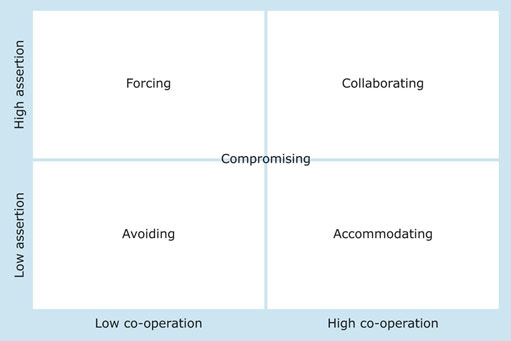6 Managing conflict
Conflict will occur almost inevitably in groups and teams – and between individuals who do not necessarily work together in a group or team. Conflict can arise through:
- Misunderstandings between individuals; these often arise by accident.
- Differences in beliefs and values; these may be personal beliefs or values, or may arise from structural divisions in the organisation, for example, production and marketing.
- Differences of interest and ambition; such differences can result in competition for power, status and resources.
- Interpersonal differences: people have different personalities and temperaments.
- Feeling and emotions: people may have strong feelings and emotions but disguise them in work settings by talking about ‘the principle of the matter.’ Conflict itself can arouse emotion, leading to further conflict.
Not all conflict is destructive, however. Some conflicts are best discussed openly: managed constructively, such discussions can lead to deeper understanding and better decisions. The problem is that conflict tends to be seen in terms of win–lose – that is, one argument will win and the other will lose. But it is possible to reach an outcome in which elements of both arguments are accepted – a win–win situation. Negotiations over pay are a simple example: employers may agree to pay employees more in exchange for changes in working practices. For win–win outcomes, however, there need to be mechanisms for open discussion and fair decision-making. The likelihood of resolving conflict depends on the behaviour of those involved. To understand this better, it can be helpful to classify people’s responses to interpersonal conflict in five categories (Figure 4). These categories reflect the balance between cooperation (attempts to satisfy the other person’s concerns) and assertiveness (attempts to satisfy your own concerns).

Forcing represents the wish to satisfy one’s own needs at the expense of others’ needs. It may involve the use of formal authority, physical threats, majority rule, or disregarding the claims of the other person. This form of conflict management usually results in hostility and resentment and is an extreme example of a win–lose strategy. Nevertheless, sometimes it is necessary – in matters of health and safety, for example, or at times of crisis.
In contrast, accommodating satisfies the needs of the other person at the expense of one’s own needs, often to maintain friendly relations. It may work when the quality of the relationship is more important than other considerations. However, it can lead to difficulties: discipline is seen to be negligible, decision-making becomes difficult and you lose respect and self-esteem – a win–lose situation.
Avoiding potential conflict is a common response to confrontation, particularly if a manager lacks self-confidence. It is the classic lose–lose situation, creating frustration and tension because issues are never resolved. Its use is normally justified only when an issue is unimportant or when time is limited.
Compromising seeks to obtain partial satisfaction for both parties. It is the preferred strategy of many managers since it avoids some of the adverse consequences of other behaviours. It is particularly useful in complex situations and where there is time for negotiation and discussion.
The only truly win–win strategy is collaborating, seeking to find solutions that are understood and appreciated by all parties. The focus is on the problem, not on personalities, blame or fault. It requires you to be both assertive and cooperative, and works when there is time to establish a collaborative environment.
